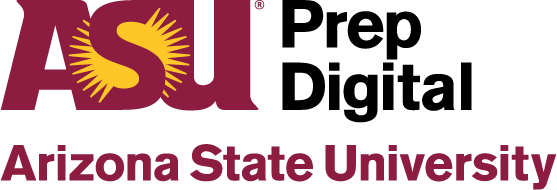Taking College Courses in High School
High school has evolved since the days of our parents. We no longer have to follow the same track. Our schooling isn’t limited by old notions that high school means following a traditional curriculum. In fact, many students are discovering that they can get a head start on college by taking concurrent enrollment classes while still in high school.
Concurrent enrollment is an excellent option for high school students, which allows them to enroll as non-degree-seeking students at a university and take courses for full credit (while also receiving high school credit needed for graduation). The opportunity to enroll concurrently isn’t always available with online programs – but schools like ASU Prep Digital, which is chartered by Arizona State University, have found ways to make this option accessible on a global scale.
A concurrent student example
Jerah Francone, a high school senior at ASU Prep Digital, is concurrently enrolled in ASU’s Exploring Sustainability Science course, taught by professor and Director of Research and Development, Annie Hale, and designed under the leadership of 2001 Nobel Prize-winning scientist Lee Hartwell.
Jerah said he likes the class because it corresponds to interests outside the classroom. One example comes from Jerah’s entrepreneurial mindset. He freelances as a digital marketer and is currently helping a start-up guitar company in Kentucky. The company is looking for ways to get wood from the community for the guitars they craft. Jerah is able to correlate what he’s learned in Sustainability Exploration to the work he does for the guitar company. The production of a single guitar involves hundreds of different systems.
“Everything is connected, and I’ve been able to take what I’m learning in the class, see how everything corresponds to each other, and how the ecosystem is being affected.”
– Jerah
Explore your future major
As a student taking ASU courses, while finishing his high school courses at ASU Prep Digital, Jerah said he is using this time to explore possible college majors.
“A lot of times, when kids are going into college, they don’t know exactly what they want to do, so being able to take concurrent enrollment classes can help them hone in,” Jerah said. “For me, it’s been a good experience because I’ve taken these classes, and I’m like, ‘okay this is what college is going to be like, and if I like this section, then maybe I should go into something like this.’ So, it gives us more of a first-hand experience with college, in a low-risk environment, since it’s still high school.”
Professor Hale agrees. She explained that ASU Prep Digital students attending university classes, like hers, will be able to get a taste of what life is like after high school. It helps to demystify college a little bit. And because ASU attracts online students from all over the world, ASU Prep Digital students might have classmates in Arizona, the east coast or even Beijing.
Sustainable conversations
Jerah’s online sustainability class is built in a digital storytelling format; incorporating compelling and engaging videos that speak to course topics. There is no textbook or long required reading assignments, it’s all about watching and reacting to the videos that highlight real-world events shaping our society and planet. Hale, and the team at the Biodesign Institute at ASU, have created these videos to engage learners in an interesting way. Jerah and other students in the online class are then invited to form and share their perspectives on what they are learning through assignments that go beyond traditional writing prompts.
Ultimately, the goal is to apply those learnings to the world at large.
“I think it’s a really great class for an ASU Prep Digital student audience because it’s video-based and it’s really fun,” said Hale.
“Every video has become an interdisciplinary course brought to you by experts across the fields of sustainability, education, science, and technology studies to create a holistic perspective of sustainability…”
– Professor Hale
She went on to explain, “…we designed the course in such a way that students can engage with ideas from a variety of different experts and perspectives. We never want it to be ‘here’s what sustainability is’ but rather here’s the conversation about sustainability,”
Ultimately, when students complete their concurrent course for the semester, they leave with a richer understanding of how to be a successful college student.
“What we are teaching will benefit students in all areas,” Hale said. “If you’re a high school student and you’re learning about these concepts now, you are transformed by having this knowledge. You’re suddenly a different freshman at ASU or any university. You’re armed with the ability to critically analyze and explore and articulate about the world around you, and that is really what every college class wants you to do.”
To learn more about concurrent enrollment courses, read this blog post.


